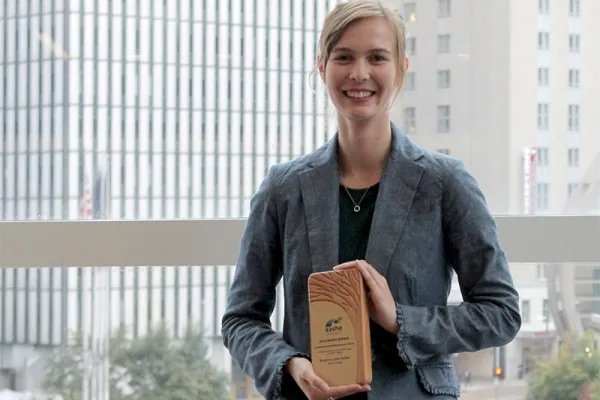Leading the Way: Modeling Carbon Pricing
Sustainability

Published October 11, 2018
When Breanna Parker ’18 began working on a strategy to help Smith reduce its carbon footprint, she didn’t expect her research to become a national model. But that’s just what happened with a carbon-pricing tool that Parker helped create for the college during her senior year.
Building on the work of Smith students and faculty—as well as recommendations of the college’s Study Group on Climate Change—Parker designed a carbon pricing strategy that is part of a toolkit being distributed by the national Carbon Pricing in Higher Education Working Group.
The toolkit—developed by Smith, Yale, Swarthmore and other colleges in collaboration with Second Nature and the Carbon Pricing Leadership Coalition—includes case studies and recommendations on how colleges and universities can put a price tag on carbon emissions to demonstrate the environmental costs of specific products and technologies.
A fundamental question our society faces is how we are going to do things differently to avoid the potentially catastrophic impacts of climate change.
“The societal costs of fossil fuels are largely unaccounted for in current pricing structures,” says Parker—whose research recently won a prestigious Campus Sustainability Research Award from the Association for the Advancement of Sustainability in Higher Education. “Our goal was to put a price on carbon to make those costs visible to decision makers.”
After studying carbon pricing, Parker recommended that Smith set its price at $70 per metric ton of emissions—an amount that was approved by the college’s Committee on Sustainability. The carbon price can be used to evaluate energy efficiency and carbon-saving measures in campus capital projects. For example, Parker conducted a pilot analysis of an upcoming Washburn House renovation and was able to use the proposed carbon price to identify ways to reduce the building’s carbon emissions.
Now used by many corporations and governments, carbon pricing is starting to gain traction in higher education, says Alex Barron, assistant professor of environmental science and policy. He emphasizes that colleges and universities can play an important role as laboratories for carbon-pricing models—while also raising public awareness about pollution from fossil-fuel emissions.
“A fundamental question our society faces is how we are going to do things differently to avoid the potentially catastrophic impacts of climate change,” says Barron, who helped develop Smith’s strategy with Parker, Sustainability Director Dano Weisbord and Susan Sayre, an assistant professor of economics. “It’s exciting to see Smith as a test site for how institutions can manage their carbon emissions.”
Barron and Mike Howard, Smith’s executive vice president for finance and administration, recently spoke at a climate action summit in California, where Smith’s carbon pricing approach was cited as a model.
“At Smith, environmental sustainability is embedded in a larger strategy tied to our mission,” says Howard. “When we share our story with other institutions, we can help effectuate even broader, positive change.”
In addition to guiding building renovations and other campus planning decisions, carbon pricing is an ongoing focus of teaching and research at Smith. This semester, for example, Gray Li ’19 and Sayre are conducting research to further refine the college’s carbon-pricing plan.
“Carbon pricing is a fascinating tool for climate-change mitigation,” Li says. “While larger-scale policies might receive more resistance in the process of implementation, institutional carbon pricing can really cause changes in the margin.”
Parker, who now works as a renewable energy analyst at Competitive Energy Services in Portland, Maine, has been asked to share information about Smith’s carbon-pricing strategy with her company.
“The opportunity I had at Smith to take complex issues I learned about in my classes and actually see them implemented within the institution was inspiring,” she says. “There’s a lot of potential for this experience to shape my career going forward.”
Breanna Parker '18 won a prestigious AASHE award for a carbon-pricing strategy she helped develop for Smith. Photo courtesy of AASHE.